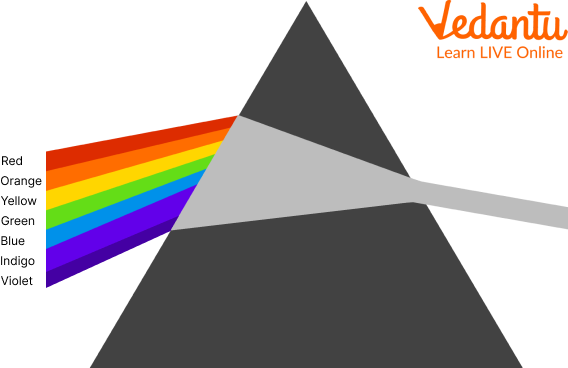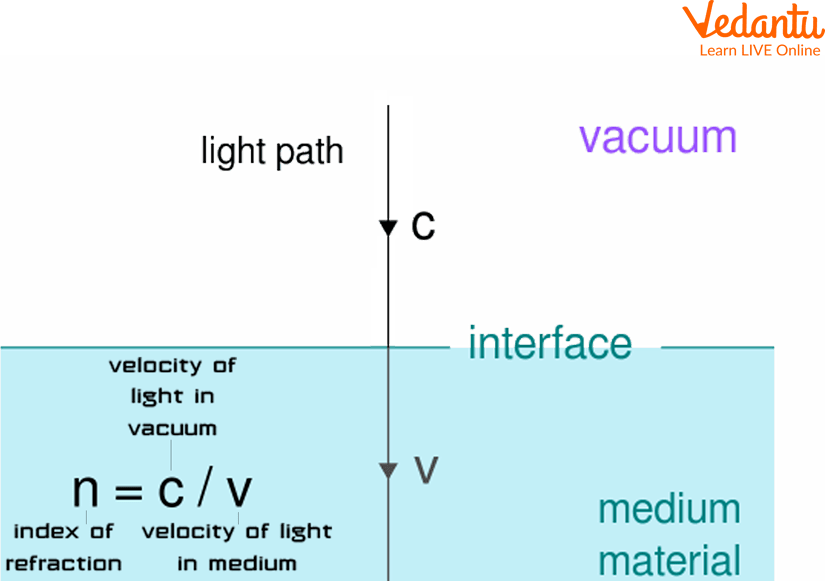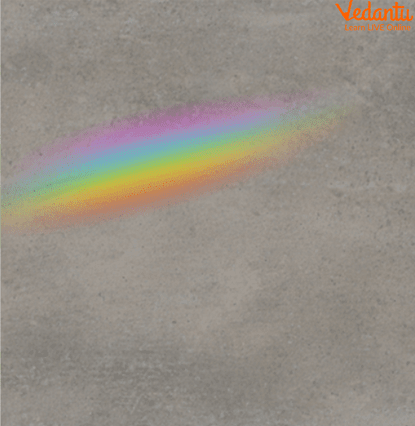




How Does a Prism Split White Light?
Have you ever seen a beam of white light coming through your window then splitting and forming a rainbow on the ground? This phenomenon of splitting white light into its component colours is known as dispersion.
White light consists of seven different colours. This means white light is a mixture of every other colour, i.e., violet, indigo, blue, green, yellow, orange, and red. Just like a rainbow where white light from the Sun comes out and falls on a raindrop following dispersion and split up into its seven component colours (VIBGYOR - VIOLET, INDIGO, BLUE, GREEN, YELLOW, ORANGE, AND RED, respectively)

Dispersion through a Window
What is Dispersion?
The natural phenomenon by which white light is split into seven colours is known as Dispersion.
Why does Dispersion Happen?
Dispersion of white light into its components is basically due to the change of speed of light of different wavelengths due to a change in density of objects or surroundings through which the light is passing through.
How are different colours placed in different locations?
As there comes a change in the density of the medium through which light is passing the properties of the waves also change. Such as:
Particles of the waves start covering a distance in a different time interval than it normally does.
The distance between two consecutive crests (highest displacement) and troughs (lowest displacement) also changes.
The above causes changes in the wavelength of a particle in motion through a medium. With the change in wavelength comes variations in the bending of light. Every particular colour has a different wavelength due to a clear distinction of every colour. For example, red has the maximum wavelength and hence is less deviated, whereas violet has a minimum wavelength and hence is the most deviated. Due to which all different colours are dispersed and are made visible at different intervals as can be seen in the given image.

Deviation of Colours
Refraction and Refractive Index
As stated above, the splitting of white light into seven different colours happens due to a change in the density of the medium the light is passing through. This change in density of the medium causes light to bend, this phenomenon is called refraction and also causes a change in the speed of the light. That is why light travels faster in the rarer medium whereas travels slower in denser medium.
The ratio of the velocity of light in a vacuum with respect to the new velocity caused by the change in medium is called the refractive index of a medium. The phenomenon of refractive index is important while dealing with refraction. It tells us about how a particular kind of light is going to react in a particular medium while travelling and coming out of it. It also helps us to identify how the light is going to bend during its path.

Formula for Calculation of the Reflective Index of a Material
Experiment to see the Phenomenon of Dispersion at Home
White light is basically the mixture of rainbow colours and when it splits, it forms a beautiful rainbow.
Warning: Adult supervision is necessary for any experiment for children. Do not look directly at the sun or into the reflection of the sun in a mirror.
Materials - water, sunlight
Tools - clean glass and a small or hand mirror
Instructions
Fill the glass with water.
Put the mirror into the water such that it is at an angle
Place the glass such that sunlight light falls directly onto the mirror. You may have to make shifts in the mirror's placement to find the correct angle.

Placement of Mirror Inside the Glass filled with Water
Find a reflection on any wall. It will be easier to see if the room is dark.
Adjust the position of the mirror till you see a rainbow on the wall.

Splitting of White Light
Summary
The phenomenon of splitting of white light is a very unique yet fascinating phenomenon occurring in nature. Through this phenomenon, one can identify the constituent visible colours composing a ray of white light. The most wonderful example of the same is the formation of a rainbow after rain which follows the principle of dispersion. Dispersion or the phenomenon of splitting of white light comprises various other phenomena that act simultaneously to perform this splitting, those phenomenons can be refraction, reflection, change in density of medium, relation of change in density in medium, speed of light, bending, relation of wavelength, and much more.
FAQs on Splitting of White Light Explained
1. What is the splitting of white light called, and what is the resulting band of colours known as?
The phenomenon of splitting white light into its constituent colours when it passes through a transparent medium is called dispersion. The band of seven colours obtained after dispersion is known as a spectrum.
2. What are the seven colours of the spectrum in the correct order?
When white light disperses, it splits into seven colours. In order from the most bent to the least bent, the sequence is: Violet, Indigo, Blue, Green, Yellow, Orange, and Red. This order is commonly remembered using the acronym VIBGYOR.
3. Why does white light split when it passes through a prism?
White light splits because it is composed of multiple colours, and each colour travels at a slightly different speed within the prism's glass. The speed of light in a medium determines how much it bends (refracts). Since violet light travels slowest, it bends the most, while red light travels fastest and bends the least. This difference in the angle of bending for each colour causes them to separate from each other.
4. How does the wavelength of light influence its dispersion?
The amount of bending is directly related to the light's wavelength. Light with a shorter wavelength (like violet) refracts more and bends at a sharper angle. In contrast, light with a longer wavelength (like red) refracts less and bends at a shallower angle. This is the fundamental reason why different colours separate during dispersion.
5. Besides a prism, what are some real-world examples of light dispersion?
Dispersion is a natural phenomenon that can be observed in various situations. Some common examples include:
- Rainbows: Formed when sunlight passes through and disperses in tiny water droplets in the atmosphere.
- Soap Bubbles: The thin film of a bubble causes light to refract and disperse, creating swirling patterns of colour.
- Bevelled Edges of Mirrors: The angled edges of a mirror can act like a prism, splitting light that passes through them into a small spectrum.
- CDs and DVDs: The shiny surface of a disc has microscopic grooves that diffract and split light, creating a rainbow-like effect.
6. If a prism can split white light, can the colours be recombined to form white light again?
Yes, the spectrum of colours can be recombined. As demonstrated by Isaac Newton, if a second prism is placed in an inverted position next to the first one, it can intercept the separated colours. This second prism refracts the colours in the opposite direction, causing them to merge back together and emerge as a single beam of white light. This proves that a prism only separates existing colours, it does not create them.
7. What is the difference between refraction and dispersion of light?
Refraction is the bending of light as it passes from one medium to another (e.g., air to glass). Dispersion is a specific result of refraction. It is the separation of white light into its different colours because each colour refracts, or bends, at a slightly different angle. In short, refraction is the cause, and dispersion is the effect.









